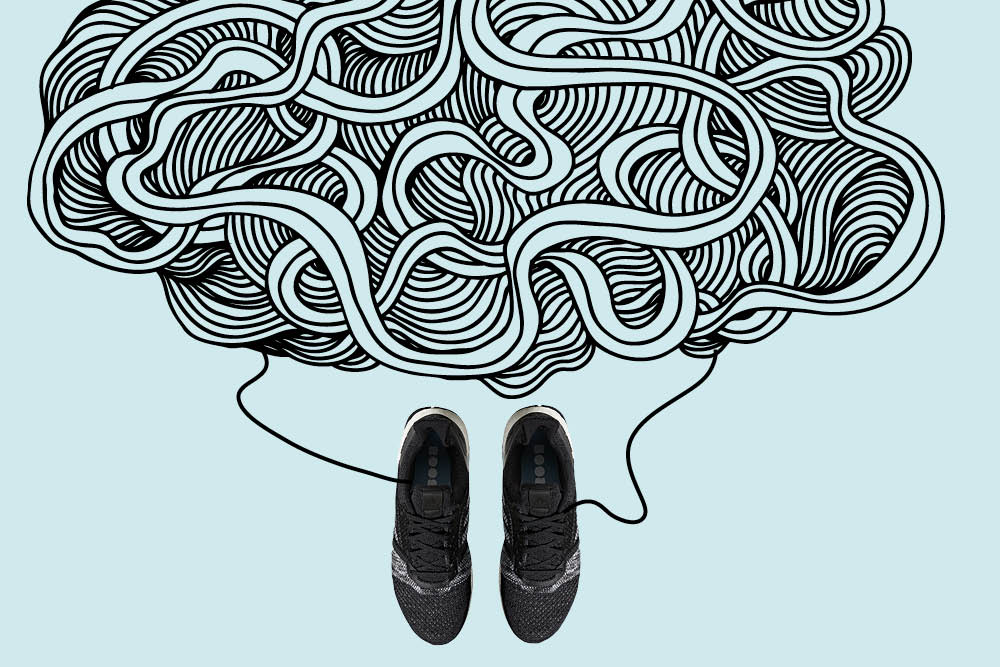Mindful running is a thing

The list of worries that can take runners out of the moment is seemingly endless; bad weather; ruminations about the past, fear of failure, stress associated with future ambitions among them can all cause a spiral of negativity.
This discontent is driven by a distracted mind that pulls us away from simply focusing on putting one foot in front of the other. We get so caught up in our push to complete a race, reach a goal, finish a new workout or just get a run over with that we miss out on the joyful aspects of the journey itself.
Mindful running, at its core, is attention training. It’s all about learning to be more present-focused. Every time you notice your mind has wandered, you guide it back to the present moment. Over time and training, the neural networks that support a present-centred modus operandi become more robust.
The good news for runners is this doesn’t need to be practiced sitting in the lotus position; you can apply this type of mental training to your day, enhancing enjoyment of your workouts and potentially performance, too. Better yet, it is a technique available to any runner, irrespective of their pace, goals, or training grounds.
All mindful running requires is an intentional effort to pay attention to the task at hand; environment, body and mind. As such, it teaches you to lean into experiences with more intention and ease, whether that’s brilliant scenery, a big hill, or bad weather, and offers you insight when adjustments are necessary.
FATAL DISTRACTIONS
Consider some of the benefits of mindful running. Pain is an oft-researched subject in contemplative neuroscience, the field that examines the impact of mindfulness training.
Studies suggest that the more we push away suffering, the more intense it becomes. Runners are often guilty of looking for ways to distract themselves so as not to experience the discomfort associated with physical exertion.
Ironically, disconnecting from those sensations actually makes them worse.
Mindfulness guides you to tune into and accept the discomfort of running in unfavourable weather or pushing in the final stretch of a race. Research demonstrates that by doing this, you change your relationship to pain and discomfort, effectively disarming it.
It’s not that you won’t feel those things, it’s just that you avoid wasting energy and making the situation more challenging by piling on additional angst.
‘Ultramarathon Man’ and bestselling author Dean Karnazes, 55, who won the infamous Badwater Ultramarathon in Death Valley (135 miles at temperatures of 49°C) among other exploits including the 50/50/50 – 50 marathons in 50 US states over 50 consecutive days – has a unique view on the suffering that can accompany running.
EMBRACE THE STRUGGLE
‘About 10 years ago, I started using this mindful running approach to deal with low points during races; those really difficult times when you just feel like you can’t go on,’ he says.
‘I’ve tried using positive mantras and other things, but with pain, you can’t fake yourself out. Really tuning into the pain and embracing the struggle is more effective because it dissipates its impact.’
What’s more, mindfulness can help you disentangle the discomfort of exertion from that associated with a potential injury.
Research has shown that a mindful mindset trains greater body awareness.
Instead of mindlessly running a scheduled workout at all costs, you tap into how your body is feeling and make intentional decisions on when to push and when to back off.
With more than half of all runners getting injured on an annual basis, many of us could stand to listen to our bodies and better recognise overtraining and impending injuries.
A mindful approach to running also helps you steer away from negative thinking (‘I’m so slow’, ‘I suck at running’ and so on). Mindfulness trains you to notice those thoughts and then to guide your mind back to the present moment without giving too much meaning to them. It’s perfectly normal to have unproductive inner deliberations, but the key is not to buy into them.
It’s all about noticing and redirecting, rather than mindlessly chasing the thought down a rabbit hole of negative rumination.
As you might expect, research shows mindfulness boosts self-confidence, increases optimism and people report actually enjoying exercise more when they remain in the moment during a workout. That joy likely comes from embracing the entire panorama of the running experience with a mind of acceptance. Your burning quads going up a hill, sweat on your brow, the morning sunrise, and of course, the sense of accomplishment when you finish.
START SMALL
So how do you actually become a more mindful runner? It can be practiced in just about any setting, whether that’s a forest trail, an urban walkway, or even on a treadmill.
And you can choose to invoke a mindful mindset for just a few moments or an entire run. Try the exercises within this feature to begin mindfully plugging into the day-to-day journey of training.
Mindful Running by Mackenzie L Havey (£8.99, Bloomsbury) is available in all good bookshops now.
TIPS FOR ON THE RUN
Environmental Scan
1. Bring awareness to your surroundings while lacing up your shoes.
2. As you start your run, engage each sense to get a full picture of your environment.
Body Scan (while running)
1. Bring awareness to the top of your head and scan down your face, jaw, neck and shoulders.
2. If you notice tension, bring your attention to it and see if you can relax.
3. Bring awareness to your arms and legs as they move.
4. Continue scanning down until you reach your toes.
Mind Scan
1. Identify the three thoughts uppermost in your mind.
2. Take stock of the pace of your thinking. Is your mental weather calm today or hurried?
3. As thoughts pop into your head, simply label them ‘worrying’ or ‘planning’ and then redirect your attention to your breath or footfall.
4. Continue anchoring your attention this way for the rest of the run or as long as you’re comfortable doing so.
KEEPING FOCUS
Taking a moment to tie your shoes with greater intention can serve as a micro-meditation, setting the stage for a more present-focused run.
Begin simply by paying attention to how your foot feels as you slide it into your running shoe.
Notice how the arch of the shoe meets the arch of your foot. Pay attention to how it feels as you tie the shoe and the upper wraps around the top of your foot. Feel the laces between your fingers as you do this. Then do the same with the other shoe.
If you notice your mind wandering or zoning out, gently redirect it to the process of simply tying your shoes.








